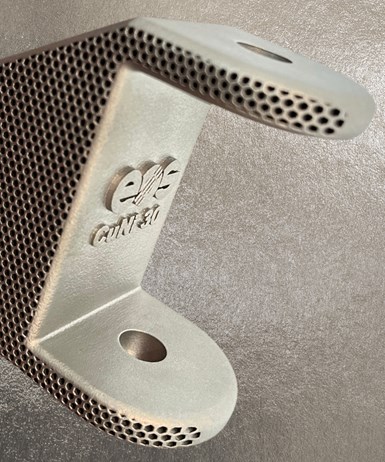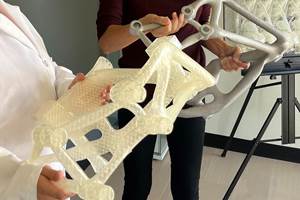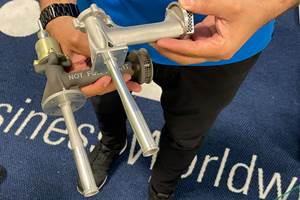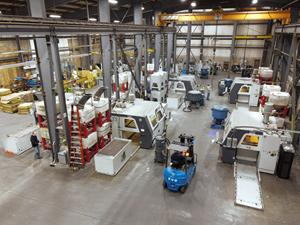EOS Works With Phillips Federal, Austal USA to Develop CopperAlloy CuNi30 for US Navy Submarine Industrial Base
Using the copper-nickel alloy in combination with EOS’ platforms offers new design and production capabilities for U.S. Navy submarines, while also enabling the agency to limit global supply chain disruption because parts can be produced regionally, locally and on-demand.
(left to right) Admiral Scott Pappano; President of Phillips Corp. Alan Phillips; Secretary of the Navy, Carlos Del Toro; Sr. Vice President Global Additive John Harrison. Source: Phillips Corp.
Working with Phillips Federal and Austal USA, EOS has developed a copper-nickel (CuNi) material for the U.S. Navy Submarine Industrial Base (SIB) to mitigate casting supply chain delays. The material was tested and developed to meet the goal of “2+1 Columbia and Virginia Class submarine platforms” for the U.S. Navy.
The copper-nickel alloy meets UNS C96400 specifications and was engineered specifically for laser powder bed fusion (LPBF) industrial additive manufacturing (AM). It is well suited for the marine, energy and chemical industries, providing excellent corrosion resistance in salt water and sustained performance in low temperatures.
The CuNi30 material was developed and tested to alleviate the supply pressure of traditional castings. Source: EOS
The material in combination with EOS’ platforms offers new design and production capabilities for U.S. Navy submarines, while also enabling the agency to curb global supply chain disruption because parts can be produced regionally, locally and on-demand. The material is now available commercially.
EOS CopperAlloy CuNi30 delivers excellent performance and material properties with a combination of high strength and ductility, around 510 MPa UTS and more than 20% elongation. The material achieves excellent corrosion resistance in salt water and sustained performance in low temperatures. With these mechanical properties, EOS has successfully met UNS C96400 specifications as mentioned in ASTM B369-09 for mechanical performance.
The CuNi30 material was developed and tested to alleviate the supply pressure of traditional castings and meet the goal of “2+1 Columbia and Virginia Class submarine platforms” for the U.S. Navy. Phillips Federal notes that the material’s exceptional performance combined with the competitive cost-per-part (CPP) has created a strong business case for production implementation.
“EOS was provided with a strategic objective to deliver a CuNi30 product to the U.S. Navy submarine industrial base to mitigate casting delays; a material holding unique to the naval construction industry and not widely available for AM technology use,” says Dr. Ankit Saharan, senior manager of metals technology at EOS. “We acted with priority to support the submarine program schedule, and we are pleased to share our successful product release within a few months of the project start. It is a privilege to contribute to projects of such strategic importance to our national interests.”
Supply Chain Efficiencies, Accelerated Lead Times and Reduced Inventories
Traditionally, manufacturing of CuNi alloy applications is done by casting and can be costly due to testing and quality requirements. There is also a lack of suppliers who can meet the application requirements. With the combination of EOS CopperAlloy CuNi30 and the quality and productivity of EOS platforms, these applications can now meet both requirements, while also opening new design and production capabilities industrial 3D printing affords manufacturers. The fact that parts can now be produced regionally, locally and on-demand is another huge advantage.
“We are grateful for the response from EOS and the Additive Minds team to develop EOS CopperAlloy CuNi30 so quickly,” says John Harrison, senior vice president of global additive at Phillips Federal. “This alloy is critical in many marine applications and will be important in our efforts to support the U.S. Navy Center of Excellence.”
EOS CopperAlloy CuNi30 is now commercially available for the midframe EOS M 290 and the large frame EOS M 400, followed by the four-laser EOS M 400-4 later in 2024.
Related Content
Casting With Complexity: How Casting Plus 3D Printing Combine the Strengths of Both
Aristo Cast is advancing a mode of part production in which casting makes the part, but 3D printing enables the geometry.
Read MoreIntrepid Automation: How Investment Casting Benefits From High Speed DLP
Vat polymerization 3D printing for investment casting patterns offers a way to deliver design freedom at production speed.
Read MoreQualification Today, Better Aircraft Tomorrow — Eaton’s Additive Manufacturing Strategy
The case for additive has been made, Eaton says. Now, the company is taking on qualification costs so it can convert aircraft parts made through casting to AM. The investment today will speed qualification of the 3D printed parts of the future, allowing design engineers to fully explore additive’s freedoms.
Read MoreLooking to Secure the Supply Chain for Castings? Don't Overlook 3D Printed Sand Cores and Molds
Concerns about casting lead times and costs have many OEMs looking to 3D print parts directly in metal. But don’t overlook the advantages of 3D printed sand cores and molds applied for conventional metal casting, says Humtown leader.
Read MoreRead Next
3D Printing Brings Sustainability, Accessibility to Glass Manufacturing
Australian startup Maple Glass Printing has developed a process for extruding glass into artwork, lab implements and architectural elements. Along the way, the company has also found more efficient ways of recycling this material.
Read MoreAt General Atomics, Do Unmanned Aerial Systems Reveal the Future of Aircraft Manufacturing?
The maker of the Predator and SkyGuardian remote aircraft can implement additive manufacturing more rapidly and widely than the makers of other types of planes. The role of 3D printing in current and future UAS components hints at how far AM can go to save cost and time in aircraft production and design.
Read More4 Ways the Education and Training Challenge Is Different for Additive Manufacturing
The advance of additive manufacturing means we need more professionals educated in AM technology.
Read More
























